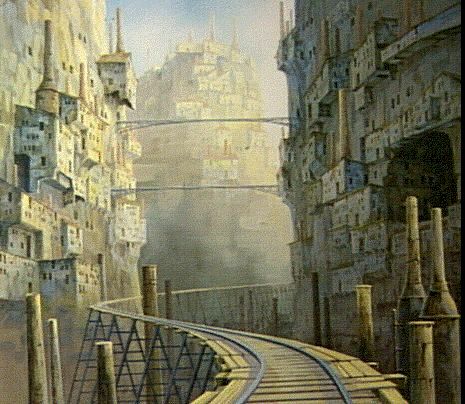First off, let it be known that I love cyberpunk as a genre. I love what imagined future societies can reveal about what we turn a blind eye on in our own society. I love the predictive nature of cyberpunk fiction--how it seems, like science fiction in general, not only to be able to predict technological trends, but also social, political, and economic trends.
Indeed, societal factors feature prominently in much of cyberpunk fiction, allowing for an entire genre--more than any other genre since the satire (Irish babies, anyone?)-- that provides starkly revealing (but at the same time entertaining) looks at the world we are building for ourselves.
"Skinner's Room" (1991) follows this model. It tells of a massive, physics-defying slum built skywards on San Francisco's Bay Bridge. Getting into the story, I was reminded once again of how absolutely drool-worthy Gibson's prose is. My imagination was captured by descriptions of the bridge's "riot of secondary construction", its "makeshift ligatures of taut and rusting wires", "borrowed neon" , "surfaces of plywood, marble, corrugated plastic, polished brass, sequins, Styrofoam, tropical hardwoods, mirror, etched Victorian glass, chrome gone dull in the sea air." Somehow, the descriptions brought up memories of Studio Ghibli films, which often feature maze-like, hacked together, impoverished settings that still maintain the sense of freedom and mystique that Gibson's bridge slum has in this story. (I can't speak for the other Bridge stories. Apparently the notion of this slum later became a trilogy)
So, being set in a slum, the social commentary element is obviously there, though not exactly spoken to directly. What is spoken to directly his the slum's history. This is partly due to the age of the title character, who appears to be quite old, and who has, to the best of anyone's memory (though memory in this story is not very good, reality getting mixed up in dreams) grown up with the slum from its inception. The girl who looks after Skinner (known only as "the girl") is as mysterious as Skinner himself. While his past is nearly forgotten, her past is barely mentioned (perhaps something she *wants* to forget), and yet she seems to have a thirst to know more about the city and society as it was before traffic bridges were shut down and taken forcefully for makeshift housing in an obviously overpopulated and polluted world.

Indeed, the story hardly tells us anything definite at all about any of its characters. In typical Gibson/cyberpunk style, the story is more in what is *not* being said, than what is. He gives us a few facts, some deliciously described memories, peppered with absolutely inconsequential dialogue, and manages to paint an entire world that the reader thirsts to know more about. The reader is almost forced to write a secondary story to parallel and fill in the blanks of Gibson's narrative, and this literary tantalization of the imagination is part of what makes Gibson one of science fiction's greats.


No comments:
Post a Comment